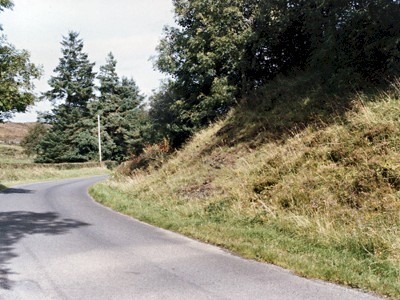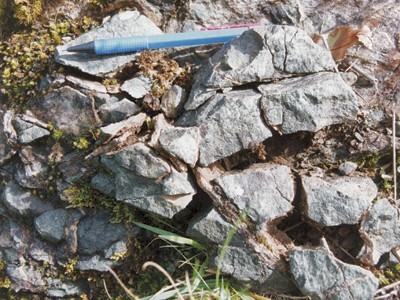Earth Science Conservation Review
| Gadalough | Fermanagh |
| Site Type: | Inland exposure, Roadside section |
| Site Status: | ESCR |
| Grid Reference: | G983603 |
| Google maps: | 54.49159,-8.02621 |
| Rocks | |
|---|---|
| Rock Age: | Precambrian (Moinian) |
| Rock Name: | Lough Derg Group, Slishwood Division |
| Rock Type: | Serpentinite |
| Interest | |
Summary of site:
This roadside outcrop exposes Northern Ireland's oldest rocks, the Slishwood Division of the Lough Derg Group. They were formed over 900 million years ago, long before the appearance of the first fossils recognisable to the naked eye. They have undergone two phases of metamorphism: the first (around 900 million years ago) was very intense, while the second was much less severe (about 470 million years ago).
Before metamorphism the rocks were mainly quartz and feldspar-rich sandstones which were intruded by basic igneous rocks, probably dolerites (with the composition of basalt) or ultrabasic rocks (with even less quartz). The basic intrusions seen here have been deeply altered during metamorphism and are now dark green to grey with rust coloured, iron-rich patches. They have been converted to serpentinite, made up of a group of minerals called serpentines (hydrated magnesium silicates) but exactly which ones is not known.
The rock body is about 50m wide and it has been suggested that the original intrusion could have been drawn from the mantle (i.e. from depths below the Earth's crust).
The importance of this site lies in its serpentinitic mineralogy, presenting a rare opportunity to investigate the process of mineral change in rocks of this composition. The actual minerals present have yet to be determined, leaving significant research potential. As at ESCR Site Croagh Mountain, the surrounding schists and gneisses contain evidence of two phases of metamorphism and their related structures.
Before metamorphism the rocks were mainly quartz and feldspar-rich sandstones which were intruded by basic igneous rocks, probably dolerites (with the composition of basalt) or ultrabasic rocks (with even less quartz). The basic intrusions seen here have been deeply altered during metamorphism and are now dark green to grey with rust coloured, iron-rich patches. They have been converted to serpentinite, made up of a group of minerals called serpentines (hydrated magnesium silicates) but exactly which ones is not known.
The rock body is about 50m wide and it has been suggested that the original intrusion could have been drawn from the mantle (i.e. from depths below the Earth's crust).
The importance of this site lies in its serpentinitic mineralogy, presenting a rare opportunity to investigate the process of mineral change in rocks of this composition. The actual minerals present have yet to be determined, leaving significant research potential. As at ESCR Site Croagh Mountain, the surrounding schists and gneisses contain evidence of two phases of metamorphism and their related structures.
| Enlander, I., Dempster, M. & Doughty, P., 2025. Gadalough, County Fermanagh, site summary. [In] Earth Science Conservation Review. https://www.habitas.org.uk/escr/summary.php?item=126. Accessed on 2025-12-14 |
| Previous Site | Next Site |

